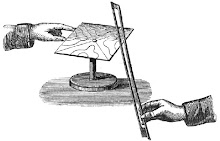I'm currently using an audio survey tool, developed by the Preservation Division of the Columbia University Libraries, to conduct a survey of a controlled sample of the recordings in the collection. A similar tool is also offered by the Sound Directions project at Harvard.
As can be seen from many of the images that I've been posting on the blog, the recordings in this collection are in poor environmental conditions, and are showing signs of damage. I'm hoping that the data generated by this survey will provide some baseline data for advocating for future preservation. I will survey a 350-item sample from the total of 5,569 recordings.
The survey tool is built on an Access database, and it is designed for use by non-specialists in recording media. It features many drop-down menus in fields that enable quick and consistent data entry. That said, it also contains many fields that can capture advanced technical details of the items being surveyed. The accompanying manual is clear and detailed, and I've found it easy to use.
However, there were a few hurdles. Firstly, it's Windows only. I use a Mac laptop, so my options were to get Windows up and running on my Mac (by using something like Parallels Desktop), or, to gather the data needed by hand, and then input the data when I had access to a Windows machine. I chose the latter.
In practice, I have a feeling that gathering data by hand may be easier and quicker for most people, but, your mileage may vary. Since surveying the materials often means clambering into hard-to-reach corners and upper shelves, I wouldn't want to be running back and forth, and the space I'm working in doesn't have a comfortable place to sit down with a laptop!
So, my solution was to mock up a paper sheet with the important fields, following the order given on the program's input form, and then use abbreviated codes to gather data by hand on the sheet on a clip-board. I know, not very high-tech! If you wanted to be more space-age, you could perhaps try to get the program up and running on a hand-held PDA or something.
All in all, it seems like quite a useful tool. I've learned some new things about audio formats, and the various forms of damage you might find, such as "cupping", "windowing", and "non-library wind" (if you really want to know, you can find some detailed imaged in this document).
I'll be posting the results of the survey here, as it is completed.
Friday, July 25, 2008
Subscribe to:
Post Comments (Atom)




No comments:
Post a Comment